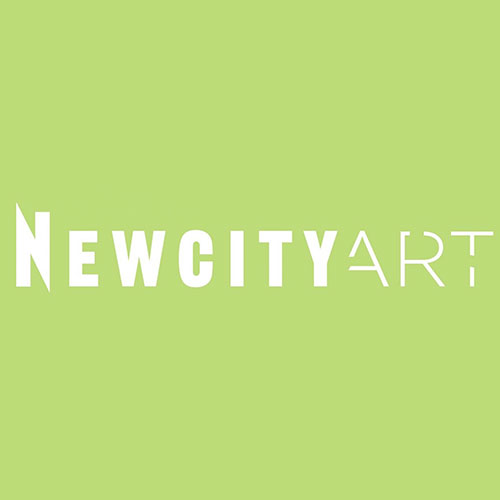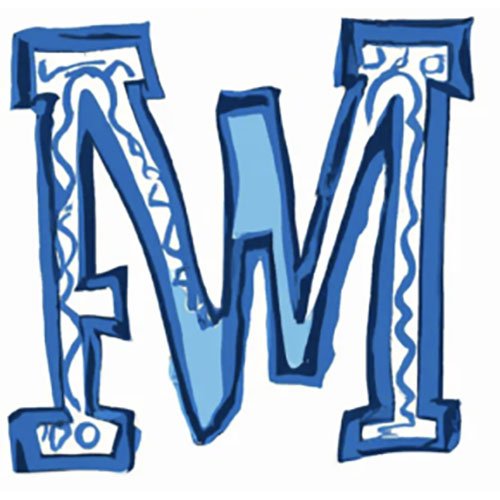
Ashkon Haidari/Photo: Max Fitzpatrick
Ashkon Haidari
Pushing a heavy red door to walk up to Ashkon Haidari’s Logan Square studio—a spacious brick building with industrial roots that houses creatives of all sorts—immediately gets you in the mood. Flooded with natural light, the space is lived-in, natural and buzzing with creative energy. Haidari is a great host: thoughtful and kind, he makes it easy to sit back and just enjoy the conversation. “I don’t have a lot to show you right now,” he admits. After two sold-out shows, he’s now working on two new pieces to have ready in time for this year’s Expo Chicago—which means I’m in for a treat! The never-before-seen work is a little different from the pieces at his latest exhibition at Povos gallery, “Under the Cherry Moon,” which was what introduced me to Haidari’s universe: Think fantastical landscapes where figures transform in extraordinary ways and forms that resemble humans, animals from distant lands and strangely shaped objects. As the artist bridges the gap between reality and the limitless realm of imagination, he achieves a modern twist on Surrealism that is hard to disregard.

Ashkon Haidari “Two Brothers,” 2022, oil on canvas, 48” x 72”/courtesy of the artist
A fish in a cat-shaped fish bowl, a figure whose head is an actual cloud, a white fox howling (is it even a fox?), an upside-down balloon, a purple umbrella… Surreal is the abnormal, the unexpected—like unusually long limbs or a monkey on roller skates. I’m mesmerized by “Two Lovers”: two lions lying atop each other, teeth bared in a display of intense affection. Surrounded by a vivid tapestry of flowers and set against a backdrop of warm, moody hues—burgundys, browns and deep reds—the life-size painting captures the essence of wild romance and fervent love. The atmosphere, enriched by the color scheme, magnifies the passionate embrace, blending the fierceness of the natural world with the tenderness of the moment.
To the Chicago-born Iranian American artist, atmosphere is of utmost importance. His paintings, drawings and etchings come from daily observations, experiences and reflections of his life and cultural heritage. “It’s different moments subconsciously registered. I paint them or draw them and then later on I realize why—it’s all very natural. And it’s exciting, too, because I don’t necessarily know where they’re coming from, you know? But I don’t question it or overthink it,” he says. “The most thrilling part is witnessing it come to life: it picks up momentum and starts to pulse, taking a life of its own. Or you just play around with it for a little bit and you’re trying to pull it out of the darkness until suddenly, it just happens. There’s nothing more I can do for it—it’s got its own legs, it’s moving, and people can see it. And that’s a telltale point.”
- Ashkon Haidari “The Singer,” 2022, oil on canvas, 40” x 60”/courtesy of the artist
- Ashkon Haidari “The Three Musicians,” 2019, oil on canvas, 48” x 72”/courtesy of the artist
Drawing was a big part of the artist’s childhood—a creative fearlessness that has stayed with him. “When you’re a kid, you don’t overthink—you just do. You’re in the moment, just creating,” he says. “I’ve carried that approach into my adult work, continuing to draw and paint without overanalyzing or interfering too much.” From drawings in the backs of notebooks during class, much to the dismay of many teachers who were eager to fail him for his inattentiveness, the artist has come a long way. And he has a good story to share: “It all started when I was in high school, not sure exactly how old, and I was hanging out at my friend’s place after school. We dumped our stuff on the table, and among the mess was one of my notebooks with a drawing in it. Tony [Fitzpatrick, Chicago-based artist], my friend’s dad, saw the drawing. ‘Hey, kid, what is this?’ he asked. I was like, ‘Just some shit I drew.’ ‘Well, can I have it?’ Without much thought, I agreed. Two weeks later, he called me up to say he’d framed my drawing and put it in an art show. ‘Come here at this time,’ he said. So here I was, an eighteen-year-old just looking to make plans for Friday night, with no idea of what was going on so I went and this was an opening. That was my introduction to the gallery world.” A few hours in, Haidari found out his drawing had been sold only to learn it was Fitzpatrick himself who bought it—at the same time giving him a real-life lesson in how the art world operates.

Ashkon Haidari “The Green Lady,” 2023, oil on canvas, 40” x 60”/courtesy of the artist
“I knew he was going to break away from the pack rather quickly,” Fitzpatrick says proudly. “He treats his muse very well—that’s by feeding it,” he adds, best describing his work as “combining Persian, graffiti and comics elements and idioms into something wholly his own that bristles with intelligence, humor and no small amount of romantic ennui.” Importantly: “Ashkon only reminds me of himself—and that’s the greatest compliment I can pay another artist.” Haidari is self-taught but always had faith in his work. So being in and around Fitzpatrick’s studio provided him with real-life experience, perspective and support that informed his trajectory. “The whole joke was that I went to ‘Tony school,’” says the artist.

Ashkon Haidari “The Thief in the Fish Market,” 2023, oil on canvas, 52” x 72”/courtesy of the artist
With a contemporary practice that is steeped in tradition—he draws from the culture and beauty of Iran—and looking up to legendary masters such as Pablo Picasso and Salvador Dalí, Haidari was never set on creating surrealist drawings and paintings. “It was only afterward that it fit,” he says. Instead, he channels the essence of the real world into his work. “The thing is, all these objects are part of nature; they’re already out there and you can see them in the world, right? For me, it’s about giving them a twist. It just happens naturally,” he explains: “It’s all one world. Like a single moment, or a collection of thoughts, dreams or passions—it can be anything, really. Imagine it as a collection of poems, like a book. When you look at some of these paintings, especially the highly detailed ones, you’ll notice that every corner, in itself, could be a painting of its own.”
“My artwork, as much as it is my blood, sweat and tears, is also a mystery to me,” he says. “It is the mirror that reflects my state of being; It is the narrator of my experience—very much a diary.” Deeply committed to his practice, Haidari thrives within the supportive community of the Povos gallery ecosystem. “Finding Lucca [Colombelli] and the Povos crew in the past few years was a huge gift in my life,” he says, grateful for a creative community that puts arts and education front and center. “We’re a bunch of artists, painters, musicians, filmmakers and writers, who are exchanging ideas and everyone is really good at their craft. It reminds me of the old Surrealist movement from the twenties,” he adds. “We’re all hardworking, ambitious—and we’re in it for the long haul. We take it seriously.” He pauses for a moment: “It’s discipline and it’s also a rhythm. Yeah, this sure is blood, sweat and tears.” (Vasia Rigou)
Source: https://art.newcity.com/2024/04/02/breakout-artists-2024-chicagos-next-generation-of-image-makers/4/




